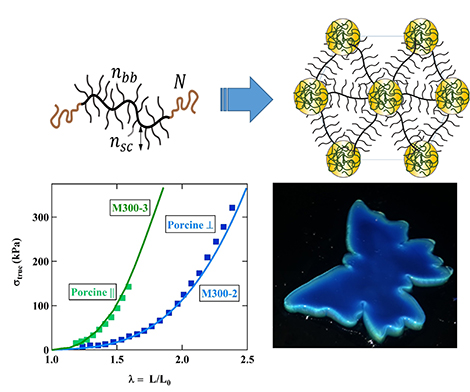Global S&T Development Trend Analysis Platform of Resources and Environment
| Polymers that mimic chameleon skin | |
| admin | |
| 2018-03-29 | |
| 发布年 | 2018 |
| 语种 | 英语 |
| 国家 | 法国 |
| 领域 | 地球科学 |
| 正文(英文) | Biological tissues have complex mechanical properties soft-yet-strong, tough-yet-flexible that are difficult to reproduce using synthetic materials. An international team has managed to produce a biocompatible synthetic material that replicates tissue mechanics and alters color when it changes shape, like chameleon skin. These results, to which researchers from CNRS, Université de Haute-Alsace1 and ESRF, the European Synchrotron, have contributed with colleagues in the US (University of North Carolina at Chapel Hill, University of Akron), are published on March 30, 2018 in Science. They promise new materials for biomedical devices.
To produce a medical implant, we need to select materials with similar mechanical properties to those in biological tissues, so as to mitigate inflammation or necrosis. A number of tissues including the skin, the intestinal wall, and the heart muscle, have the particularity of being soft yet stiffening when they are stretched. Until now, it has been impossible to reproduce this behavior with synthetic materials.
The researchers have attempted to achieve this with a unique triblock copolymer2. They have synthesized a physically cross-linked elastomer composed of a central block onto which side chains are grafted (like a bottle brush) and with linear terminal blocks at each end (See figure). The researchers have found that by carefully selecting the polymer's structural parameters, the material followed the same strain curve as a biological tissue, in this case pig skin. It is also biocompatible, since it does not require additives, e.g. solvent, and remains stable in the presence of biological fluids. Another property of the material appeared during the experiments: its color change upon deformation. As the scientists have shown, this is a purely physical phenomenon, which is caused by light scattering from the polymer structure. Atomic force microscopy and X-ray diffraction experiments have shown that the terminal blocks of these polymers assemble in nanometer spheres, distributed in a brush-polymer matrix. Light interferes with this microphase-separated structure to produce color according to the distance between the spheres; so when the material is stretched it changes color. It is the same mechanism that explains in large part how chameleons change color. The researchers have therefore succeeded in encoding in a unique synthetic polymer both mechanical properties (flexibility, strain profile) and optical properties, which had never previously been achieved. By adjusting the length or density of the brush's various side chains, these properties can be modulated. This discovery could lead to medical implants or more personalized prostheses (vascular implants, intraocular implants, replacement of intervertebral discs), and also to materials with completely new strain profiles, and applications that have not yet been imagined.  © D.A. Ivanov and S.S. Sheiko Top left: molecular structure of a plastomer synthesized in this work; right: supramolecular structure formed by the assembly of identical plastomers.  When the material is stretched, its color changes. Credit: S.S. Sheiko Download the press release:  Notes:1 At the Institut de Sciences des Matériaux de Mulhouse (CNRS/UHA) and the Laboratoire de Physique et Mécanique Textiles (UHA). Bibliography:Chameleon-like elastomers with molecularly encoded strain-adaptive stiffening and coloration. M. Vatankhah-Varnosfaderani, A.N. Keith, Y. Cong, H. Liang, M. Rosenthal, M. Sztucki, C. Clair, S. Magonov, D.A. Ivanov, A.V. Dobrynin, S.S. Sheiko. Science, 30 March 2018. DOI : 10.1126/science.aar5308 Contacts: CNRS researcher l Dimitri Ivanov l T +33 (0)3 89 60 88 07 l dimitri.ivanov@uha.fr |
| URL | 查看原文 |
| 来源平台 | Centre national de la recherche scientifique |
| 文献类型 | 新闻 |
| 条目标识符 | http://119.78.100.173/C666/handle/2XK7JSWQ/107013 |
| 专题 | 地球科学 |
| 推荐引用方式 GB/T 7714 | admin. Polymers that mimic chameleon skin. 2018. |
| 条目包含的文件 | 条目无相关文件。 | |||||
| 个性服务 |
| 推荐该条目 |
| 保存到收藏夹 |
| 查看访问统计 |
| 导出为Endnote文件 |
| 谷歌学术 |
| 谷歌学术中相似的文章 |
| [admin]的文章 |
| 百度学术 |
| 百度学术中相似的文章 |
| [admin]的文章 |
| 必应学术 |
| 必应学术中相似的文章 |
| [admin]的文章 |
| 相关权益政策 |
| 暂无数据 |
| 收藏/分享 |
除非特别说明,本系统中所有内容都受版权保护,并保留所有权利。
修改评论